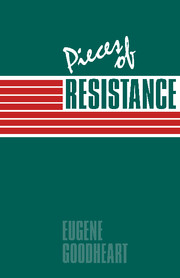Book contents
- Frontmatter
- Contents
- Preface
- Acknowledgments
- Autobiographical
- Part I Critics and criticism
- 1 William Chace's Lionel Trilling: Criticism and Politics
- 2 Philip Rahv and Image and Idea
- 3 Joseph Frank's Dostoevsky: The Seeds of Revolt 1821–1849
- 4 Leslie Fiedler and the mythic life
- 5 The “radicalism” of Susan Sontag
- 6 Paul Goodman's neolithic conservatism
- 7 Geoffrey Hartman's Criticism in the Wilderness: The Study of Literature Today
- Part II Contemporary culture in conflict
- Part III Writing in America and elsewhere
2 - Philip Rahv and Image and Idea
Published online by Cambridge University Press: 05 August 2012
- Frontmatter
- Contents
- Preface
- Acknowledgments
- Autobiographical
- Part I Critics and criticism
- 1 William Chace's Lionel Trilling: Criticism and Politics
- 2 Philip Rahv and Image and Idea
- 3 Joseph Frank's Dostoevsky: The Seeds of Revolt 1821–1849
- 4 Leslie Fiedler and the mythic life
- 5 The “radicalism” of Susan Sontag
- 6 Paul Goodman's neolithic conservatism
- 7 Geoffrey Hartman's Criticism in the Wilderness: The Study of Literature Today
- Part II Contemporary culture in conflict
- Part III Writing in America and elsewhere
Summary
Philip Rahv wrote essays and reviews. Though he intended to complete a book on Dostoevsky, it is doubtful that the book would have been more than a collection of essays. In saying this, I disparage neither Rahv's achievement nor the essay. Literary success in our culture is defined in terms of the book, whether it be a novel or a book of criticism. The writer of stories or essays can never feel content with his achievement because the shorter works, according to the cultural view, are either a preparation for the larger effort or chips off the workbench. Because the real book is always a rarity, this is unfortunate. Most “books” are made from ambition, not genuine conception; and the fine short-story writer or essayist may betray his true gift by working in an uncongenial form. Moreover the emphasis on the book is achieved at the expense of an appreciation of shorter forms.
Rahv had all the powers of the essayist. He had something important to say about the subjects or occasions of his essays. Unlike most books Rahv's essays had genuine occasions, reasons for being written. What he had to say involved bold and challenging statements about large areas of experience: literature, history, culture, society, politics. In books such statements tend to become so hedged and qualified that they lose their shape. The provocation of the essay gives way to the density of exposition. A true essayist, Rahv was impatient to make his statement with maximum force and incisiveness.
- Type
- Chapter
- Information
- Pieces of Resistance , pp. 19 - 30Publisher: Cambridge University PressPrint publication year: 1987



